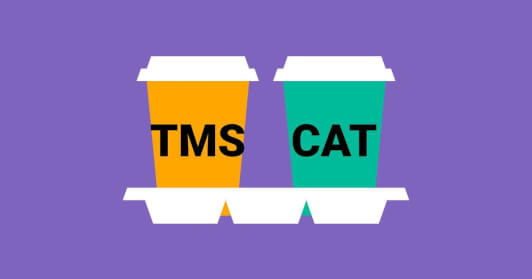Historically, many LSPs have been using TMS tools to manage translation projects and CAT tools to do the actual translations. In this article, we provide some arguments against this approach.
When you start an LSP, computer-aided translation tools are one of the first things you want to use. The need for translation management systems, on the other hand, may not manifest itself early on — or it may just be prohibitively expensive for you. You have your folders, you have your Excel spreadsheet, what else do you need? Fast-forward a couple of years, and you start realizing the overheads of this makeshift approach.
If the CAT tool you originally chose is not seamlessly integrated into a bigger solution that also includes a TMS, you are forced to look for a standalone TMS solution. The point we’re trying to make in this article is that using a separate TMS tool does not eliminate messy practices, it just makes them even messier.
“Using a separate TMS tool does not eliminate messy practices, it just makes them even messier.”
Let’s see why.
1. It’s inefficient and expensive
This one’s a no-brainer. Both CAT and TMS tools are specialized solutions, and specialized solutions tend to cost a lot. Some tools, such as Smartcat, use a different monetization model and don’t have to — or chose not to — charge by the “seat”. But in general, you can easily make three- or even four-figure payments to own a combined solution.
Let’s admit it, being forced to buy a software to manage another software is just silly. Why not simplify everything by using just one technology vendor? By combining all interrelated software flows between the CAT and TMS parts, the vendor won’t need to charge you twice the price for two closely related products.
2. It’s twice the onboarding effort
When you have two tools with different UIs and user experience, you have to train your employees to use both. And then you have to do the same with your freelancers. It’s no secret for most LSPs that onboarding someone who works on the other side of the world is no walk in the park. Now multiply this by two.
With just one tool, it’s not only the single user interface that will make the onboarding easier. It’s also the more intuitive and automated flow within different parts of the system. For example, if to make a payment you just have to accept a translation project, and the payables will be calculated automatically, it’s naturally much easier than manually transferring these calculations from the CAT tool to the TMS.
3. It’s twice the customization and maintenance costs
The more you use a specific piece of software, the more areas for improvement you start seeing. Most tools — whether CAT or TMS — have customization options, but doing this for two tools means that you’ll have to spend more time looking into what each has to offer as far as customization is concerned.
Besides, no system is devoid of flaws. As they teach in tech schools, the more complex a system, the more likely it is that something will go wrong. So when you have two complex systems side by side, and a bunch of connections between them to enable data exchange, — the probability of things getting messy more than doubles.
4. It’s two support teams to talk to
And, now that we’re talking about things going wrong, it’s of critical importance to have good support. For this reason, always check the developer’s G2 reviews to make sure that they won’t leave you hanging when you most need them. But, even with great support for your tools, with two of them, you might run into the classic blaming game of one tool’s developers pointing at the other’s.
The thing is, the boundaries between CAT and TMS are sometimes so vague that it will really be impossible to tell whether an issue relates to one or the other. For example, if an invoice shows the wrong amount, is it because the CAT tool incorrectly counted the words, or because the TMS tool incorrectly applied the translation memory discounts?
5. Buying a system just to manage another system makes no sense
Let’s face it, this ☝️ should be obvious. It’s just due to past practices and rooted-in inefficiencies that many LSPs continue doing it this way. Or, you could ask the opposite question:
In 2020, it is finally time to understand that the division into CAT and TMS, CAT and terminology management, TMS and Marketplace, and so on — all of these are a thing of the past. Today, you can have everything that you need to run your translation or localization team in one place.
Whether it’s Smartcat or another translation platform is your choice to make — but please, don’t try to put one egg in two baskets.


